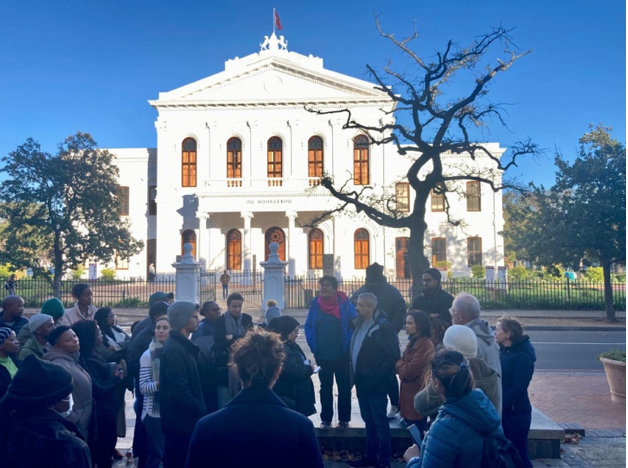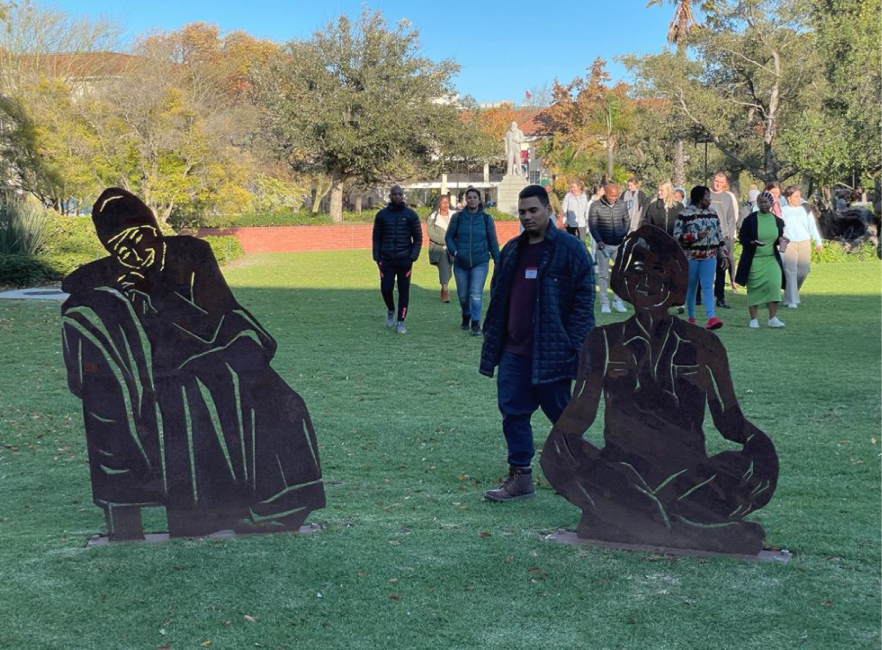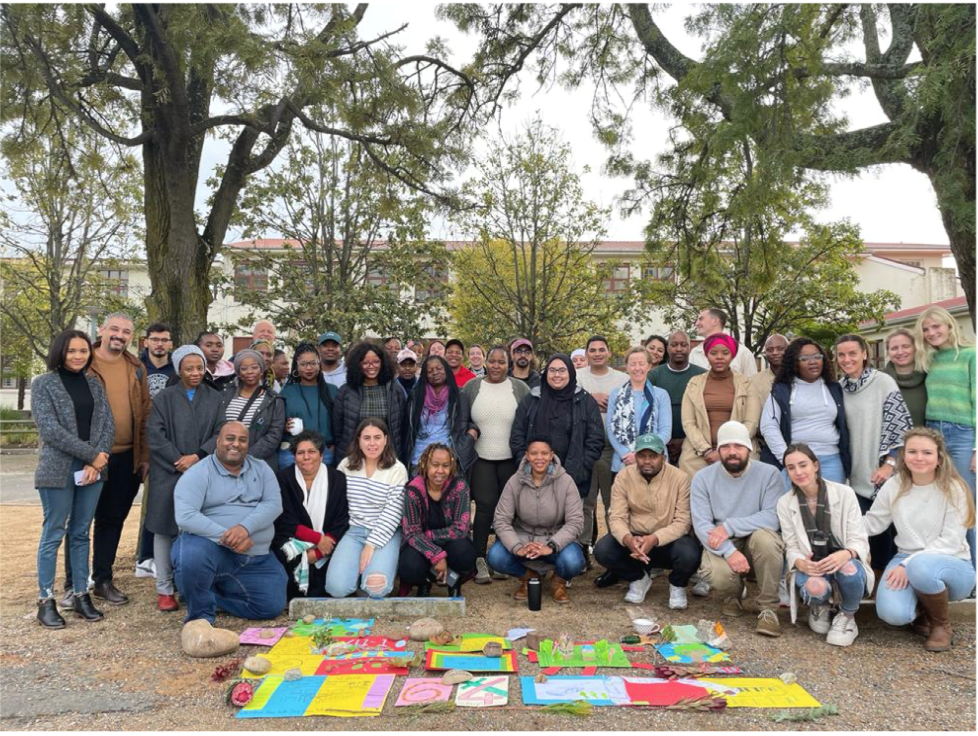Written by CST Researcher Nina Callaghan

PGDip students, module convenors and facilitators of the Globalisation, Governance and Development module began their week with a walking tour, with landmarks resonating throughout the teaching and learning content.
The best way to start any good thing is with a walk. That is how we started the PGDip Globalisation, Governance and Development module on Stellenbosch University main campus. The crisp morning sharpened our senses as our class, 50 people strong, meandered through a landscape in slow transition, taking in the buildings, the spaces in between, the names and statues, trying to imagine who and what was there before and why they aren’t here anymore. Our walking tour took us through a part of Stellenbosch formerly known as Die Vlakte, a former community of people of colour forcibly removed by the apartheid state in 1964. We stopped at the recently renamed Krotoa building, formerly called Wilcocks to reflect on the efforts at visual and cultural redress of a university with a history steeped in Afrikaner nationalism, inequality, and racial segregation. We paused at the granite statue of a certain Jannie Marais dominating the campus’s Rooiplein, marking the difference in gaze, material, and purpose against a series of steel sculptures of celebrated women of our country including Fatima Meer, Thuli Madonsela and Antjie Krog among others. This landscape and its markers and signifiers came to bear strongly in the themes we explored in our module. We were able to bring our experience and our environment directly into the classroom and apply it to our learning about political settlements, power, the state, the commons and how we make change.

PGDip students visiting ‘ The Circle’, an artwork on the Rooiplein, which is a celebration of historical, present and future women leaders of our nation.
Co-convened by CST researcher Nina Callaghan and Partnering and Systems Change Practitioner, Andrew Boraine the week-long module had a wonderful balance of theory and applied knowledge – where conceptual learning found an anchor in practical methods and approaches to being a change maker. Why do we make change? How do we do it? With whom and for whom? These questions were filtered through the theory to arrive at formulations that made remote ideas like development and governance more approachable with tools for analysis that revealed possibilities for how we could influence change. This learning was applied to our lived contexts in institutions where many of our students currently work – case studies of making change in NGOs; government; big corporations and community organisations came to life in the common language we found in this course. Dr Jess Schulschenk and Professor Mark Swilling provided valuable insights into the shifting logics of corporations and the global dynamics of finance, respectively. The week was a mosaic of change making that surfaced a leitmotif of relationality – being in relationship – with ourselves, our places, our institutions that felt simultaneously empowering and humbling for how we equip ourselves to participate in this time of transition.
Beyond new learning, students were able to locate themselves in larger landscapes of change – just as we did on our walk through the town. There was a recognition of trauma and a splintering of our fullest selves that is traditionally associated with making change or feeling the effects of change. Our learning offered possible alternatives to bring others along in change processes to facilitate not only consent but a wealth of ideas and relationships of value. There were tender moments of accepting the limitations of being a fallible and fragile human in an unjust world that found its counterbalance in the idea that change – good change, just change, is only possible in partnership with others. We heard this echoed in the urgent need to forge a global common agenda to direct finance for the Sustainable Development Goals as well as a common agenda at other scales of change, South Africa’s energy transition being front and centre of our classroom discussions. How we come together – in any room – to partner with others, to combine resources and ideas and work with diversity was at the heart of our learning. Coming full circle through the themes of the module, we arrived back in our communities, families, and bodies to appreciate that our personal, emotional, intellectual, and spiritual health matters for making change, steering it, and staying the course.

In commemorating the community of ‘Die Vlakte’, students placed their creative offerings in the walkway outside the Lückhoff Living Museum (the old Lückhoff Skool building) in Banhoek Road, Stellenbosch.
In the past this module was more about the political economy of globalisation (global trends in resource use, finance, governance and conflict – heavy stuff). This year it was mainly about the granularities of governance, in particular Nina’s inspirational work on relational governance and political settlements, and Andrew’s complementary work on being a change maker rooted in his 35 years of experience working in a public sector context as a change maker. The impact on the group was quite extra-ordinary. It was if Nina and Andrew gave them a language to make sense of their institutional trauma – by the latter I mean what it feels like to work for government and a corporate if your values are somewhere else. Finding a language that makes sense of that and empowers you to act was highly impactful. They really appreciated that. ~ Prof Mark Swilling

